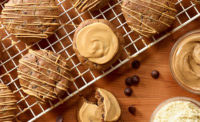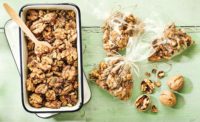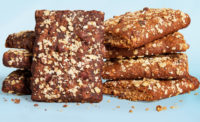The Almond Board of California (ABC) recently partnered with the Sterling-Rice Group to investigate the snacking preferences and patterns in U.S. consumers today via a Snack Mapping study. The results provide some significant insight into how people prefer to snack throughout the course of their day—and depending on their various needs and moods—pointing to multiple opportunities in the snack market today.
As snack producers target specific consumer groups as ideal candidates for products during early stages of research and development, this type of information is gold. Developing snack products that your target demographic will resonate with and regularly select for repeat purchase is always the goal.
In order to learn more about this valuable work, we reached out to Rob Renegar, insights manager, Sterling-Rice Group, and Molly Spence, director of North America, ABC.
Douglas J. Peckenpaugh: What was the methodology used for this Snack Mapping study?
Rob Renegar: For the development of the methodology and survey, we considered our normal go-to research options, and ultimately decided to try a new approach. Determining who we wanted to survey was the easy part—coming up with the actual material and questions was the hard part.We took material from our attitudes and awareness studies and added some questions about need states. We incorporated key learnings from focus groups and one-on-one interviews, all regarding snack foods and snacking. Then, we added an approach we developed from an area not directly linked to consumers and snacking: The Myers-Briggs Personality Test. This is one of the most well-known psychometric tools that helps us measure and understand psychological preferences and how we perceive and relate to our world.
We then had to figure out a method by which an item, such as a snack food, could be assigned a four-letter “type.” We had several collaboration sessions to find out how this could be achieved, ultimately landing on the core idea that we needed a set of four pairs of attributes. We needed to be selective with the four pairs of attributes we wanted to include, considering the importance of each attribute pair as they relate to snacking.
Using this newly developed approach, we then dedicated the core section of the survey to a set of questions that allowed us to “type” each snack food across a set of product attributes (experiential/physical descriptors) and usage attributes (situational/usage descriptors).
DJP: What were your primary goals of the study?
RR: The primary goal of the study was to find new insights about consumers and their snacking behaviors. This study marked the first time we used this methodology, and we saw some really impactful learnings that we can build on moving forward.
We had previous learnings from A&Us (attitude and usage studies), need-state studies and direct consumer qualitative feedback, which gave us a lot of information and data points. We were looking for a way to try and tie the data from different sources together, and we were able to do that by assigning a “type” to the snack foods we tested.
DJP: What did the results show about current snacking perspectives in general?
RR: We saw that the specific snack foods that snackers are looking for tend to be directly related to the need state they find themselves in. The most common need state that snackers reported is the “Tide Me Over” state, which means that they’re looking for a snack to satisfy them until their next major meal or eating occasion. This was followed by the “Indulge” need state, where snackers are looking for something special, enjoyable and fulfilling that is just for them. Finally, the “Nourish Me” need state is one where snackers want a snack to replenish their body and spirit while doing something good for themselves.
These three need states may be the most common among snackers, but ultimately they are looking for different snack foods when they think about their ideal snack. The various snackers are looking for snacks with different types, based on the work we did in this study. Here are some of those differences:
For the Tide Me Over snacker, their ideal snack has a product type of CADH, which represents a snack that is crunchy, salty, dry, and healthy. This includes snacks like almonds, pretzels, crackers and popcorn.
The Indulge snacker ideally wants a snack that has a product type of CWJI: crunchy, sweet, juicy, and indulgent. Interestingly, there were no singular snack foods that we tested that had this type, which may indicate an unmet need or market opportunity for a snack food manufacturer.
The Nourish Me snacker has a product type of CWJH, representing crunchy, sweet, juicy, and healthy. Based on product scores, this type aligns with some of the fruits and vegetables that snackers eat, including apples, oranges, broccoli, and other fresh vegetables.
In addition to rating specific snack foods and giving us insight on how specific snack foods might appeal/align to and across the various need states, this study also offered some new perspectives and ways in which we might look for new opportunities.
I mentioned that the ideal snack for the Indulge snacker does not align in product type with any of the snack foods we tested. While we don’t have any snacks that seem to align to this specific product type, this study does allow us to understand the specific strengths of the foods we did test. It allows us to consider combining two or more snack foods as ingredients into a new product, choosing them based on the product type we are trying to specifically address. In the case of the Indulge snacker, they are seeking a snack that is crunchy, sweet, juicy, and indulgent (CWJI). Given the results, combining almonds, strawberries and chocolate, playing on the crunch of almonds, the juiciness and sweetness of strawberries, and the indulgence (and sweetness) of chocolate, might offer a snack that fits the Indulge snacker’s ideal snack food profile.
This is just one way in which we feel this new study gives us a fresh lens through which to consider the snacking universe, evaluating how current snack foods are or are not addressing the needs of different snackers.
For an in-depth dive into the snack mapping research, see “Mapping the Snack Category: Identifying Key Trends in Snacking & Areas of Opportunity,” a free, on-demand webinar.
DJP: What are some of the attributes people today look for in snacks?
Molly Spence: In the Snack Mapping study, we found that the top three snack attributes that consumers look for are convenience (67 percent), great taste (65 percent), and appropriate for everyday use (60 percent). Flavor, texture and taste are just as important as functionality, but when it comes down to it, nutrition and convenience are the ultimate package. The good news is that almonds deliver on all of these attributes making them a go-to for product developers and consumers alike.
DJP: What are the top ingredients people want to see in snacks? Why do these ingredients resonate with consumers?
MS: According to another study on consumer preferences for their ideal ingredients in snack bars, almonds came out on top as the most popular ingredient in an “ideal bar” (U.S. Bars Exploratory Study, Sterling-Rice Group, 2014). The top fruit flavors selected for consumers’ ideal bar were strawberry and coconut (tied at 13 percent), followed by raisin (9 percent), cranberry (8 percent) and blueberry (7 percent). Check out ABC’s “Perfect Snack Bar” recipe, which combines the top ingredient selections to create an “ideal bar” based on consumer preferences.
In terms of ideal ingredient pairings for “a perfect snack,” the top consumer choice for almond pairings was chocolate at 38 percent of share, followed by granola at 25 percent, and dried fruit at 22 percent (North America Consumer AAU, Sterling-Rice Group, 2015). Another interesting insight from the study is that apples and almonds are the top two foods consumers surveyed name first as nutritious snacks. We’re seeing the tried and true combo of apple slices and almond butter elevated with various flavor inclusions and even blended into smoothies.
Almonds have consistently resonated with consumers because of their distinct taste and crunch, and are the number one nut that consumers associate with snacking. In fact, U.S. consumers surveyed eat almonds an average of 9.7 times per month, with nearly half of those occasions specific to snacking.
It’s also important to point out that there are more than a dozen botanical varieties of almonds grown in California, and each one has different attributes good for different reasons. For example, some are more attractive, some taste more “almond-y,” and some are better for seasoning adherence because they have a wrinkled skin. There are also a variety of sizes and grades. So, it’s important for food product manufacturers to be familiar with all of the options that are available to them. ABC offers an in-depth technical kit online.





